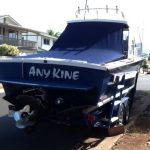Cummins Marine Diesel Repower Specialists › Forums › General Discussion › Fleetguard Fuel Filters
- This topic has 12 replies, 6 voices, and was last updated 4 years ago by
 Tony Athens.
Tony Athens.
-
CreatorTopic
-
March 11, 2017 at 1:22 pm #16230

Ron PickeringParticipantVessel Name: Anykine
Engines: 6BTA 370
Location: Waianae HAwaii
Country: United States
I use the Seaboard Double Double system for my fuel filtration. My vacuum gauges are reading about 2″-3″ mm HG. Still in the green zone. A friend who is a powerplant generator operator said the filters need to be changed out every 2 years regardless of the reading because the paper elements break down. I have never heard that. Is that something to be concerned with or should the vacuum gauge be the determining factor.
Thanks in advance.
Ron
-
CreatorTopic
-
AuthorReplies
-
December 7, 2019 at 6:30 am #84115

Tony AthensModeratorVessel Name: Local Banks
Engines: QSB 6.7 550 HP
Location: Oxnard, CA
Country: USA
On a Cummins electronic engine ( can’t speak for others as I do not know there “fuel system”), max fuel flow occurs only under load, plus on an average, total fuel flow is measurably less with the common rail engines.
As a comparison–
Max fuel flow with any QSB 5.9 is about 50 GPH at full engine load/RPM
Max Fuel flow with a 6BTA 5.9 370 is about 73 GPH and occurs at approx 1800- 2000 RPM in neutral or under load. Lower HP engine are less, sometimes way less.
Remember, don’t confuse total “fuel flow” with fuel burn or fuel consumption. Fuel consumption is a direct function of HORSEPOWER PRODUCED, and is not a direct function of RPM.. Make 100HP at any RPM and your engine is consuming about 5 GPH. In neutral at any RPM , your GPH will be between .25 GPH and maybe at WOT no-load, it may approach 1.5 GPH due to parasitic loads. So, with a 370 at 2000 in neutral, you are returning close to 70 GPH to the tank . On a QSB 5.9 at 2000 RPM in neutral, maybe 5-10 GPH to the tank?
So, to check your VAC at the dock in neutral is way easy with the mechanical engines.. On the CR engines, you need to do it at sea under load.. That is one reason a gauge with a drag pointer is nice on a CR engine. You don’t have to be looking at it.
Testing any VAC gauge in neutral is easy at the dock on any engine. Just start it up, bring it up to about 1500 RPM, look at the at the gauge. Then shut the fuel OFF before it ( tank or ??). Watch the gauge for a minute or ? —when it starts to rise (it will eventually) about 5-7 “, then open the fuel.. It will drop back to what it was.. It will HURT nothing, so IMO, learn your gauge operation.
Hope this helps.
December 6, 2019 at 6:22 pm #84104Reading your Vacuum Gauge on a Racor
“With a RACOR, a visual can give you a a decent indication, but only a vac gauge will tell you for sure. 8-10″ Hg is a good number to change at.”
When is the time to read the gauge on a Electronic Diesel engine? At idle, Cruise, etc?
December 6, 2019 at 7:20 am #84056
Tony AthensModeratorVessel Name: Local Banks
Engines: QSB 6.7 550 HP
Location: Oxnard, CA
Country: USA
Filter elements are either clean or dirty ( any yes, something in the middle too) .. For all intents and purposes, they DO NOT degrade with time (10+ years with clean #2 in them?) . If “stuff is growing inside the bowl, then that is a different story. Definitely a clear bowl can speed that up, as “light” in an ingredient for some types of this growth.
With a RACOR, a visual can give you a a decent indication, but only a vac gauge will tell you for sure. 8-10″ Hg is a good number to change at.
What is the “stuff” ? Never really had in analyzed as I’m sure there is more that one type–That’s why I call it “Mud & Crud”..
Tony
December 6, 2019 at 6:28 am #84051Racor Filters
Joel:
Mine seem to be staying pretty clean as well. How often do the Racors need to be replaced if they appear clean? Do we also watch the gauge as Tony mentioned above (10″) for the Fleetguard Filters? Do these Racors degrade over time regardless if they are dirty?Thank you for any help.
March 23, 2017 at 7:43 am #16576
Joel HildenParticipantVessel Name: Sway
Engines: Cummins 480CE
Location: Chesapeake Bay
Country: United States
Hey Tony, what causes that kind of “mud” to accumulate in the primary filter? Is it mostly dead algae, or just crud brought into the fuel tank when fueling?
If I had problems with my Racors getting gunked up and having to be replaced often I would definitely look into the Double Double system. However, my Racors seem to stay clean as a whistle and I’m just changing them once a year as a preventive measure. I put Biobor JF biocide in the tanks once a year to kill any algae. My engines have about 900 hours on them and I’m adding about 100 hours/year. I tend to buy fuel at many different marinas. Is it more the commercial operators who are running their engines for many hours everyday who have these kind of filter problems?
March 23, 2017 at 5:50 am #16566
Tony AthensModeratorVessel Name: Local Banks
Engines: QSB 6.7 550 HP
Location: Oxnard, CA
Country: USA
I wait until about 10″.. Only change the mud filter first and then check.. ( on a mechanical engine you can do it in neutral at 1800-2000 at the dock) Usually it catches 90% of the crud and lasts 3-5 time longer.. The only sure way to know what’s going on inside the tank, is to CUT the primary open and inspect.
March 23, 2017 at 5:00 am #16564
Bryan DoughertyParticipantVessel Name: Osprey Moon
Engines: Yanmar 6LY3-UTP
Location: CT or FL
Country: USA
at what vacuum gage reading do you change?
I have a double/double double fleetguard system on my boat, with vacuum gauges on both filters (FS19513 & FS1000)…I’ve only ever had the gauge on the FS1000 regester/show any vacuum. What reading do I change the filters at? Should I change both? Last time when the gauge on the FS1000 hit 8″ I changed both.
Thanks
March 22, 2017 at 6:51 pm #16555
Tony AthensModeratorVessel Name: Local Banks
Engines: QSB 6.7 550 HP
Location: Oxnard, CA
Country: USA
I am going to let Jim do his thing, but after dealing with RACORS and the time needed to service them, if my time is worth $20 an hour, I ‘d say he was being conservative.. In your scenario, if your time is 100% free and have nothing else to do but mess with your Racors, maybe it would take much longer..
I just happen to value my time as most boat owners do.
Tony
March 22, 2017 at 8:05 am #16519
Joel HildenParticipantVessel Name: Sway
Engines: Cummins 480CE
Location: Chesapeake Bay
Country: United States
James, how do you calculate the Double Double system paying for itself in two years? I did some calculations based on replacing a filtration system that has a Racor 900 30-micron primary and a FF5285 on the engine. Replacing the Racor twice a year and the FF5285 once a year would cost $49. With the Double Double, if you changed the FS19513 0.5x/year (every two years) and changed the FS1000 0.33x/year (every three years) it would average about $15 a year. That’s a $34 savings per year, so it would take about 12 years to save enough to pay for the Double Double system, not including labor. I’ll stipulate that the Double-Double is a superior filtration system, but I don’t see how it would pay for itself in two years unless you’re changing your Racor filters ten times a year.
March 17, 2017 at 7:57 am #16378
jamesParticipantWow
I was just catching up on forums and saw this item. I switched to one of Tony’s double filtration systems and got rid of my Racor’s. Simpler to service, and reading this, will pay for itself in 2 years due to not arbitrarily replacing filters!
March 12, 2017 at 11:51 am #16245
Ron PickeringParticipantVessel Name: Anykine
Engines: 6BTA 370
Location: Waianae HAwaii
Country: United States
Thanks Tony.
March 11, 2017 at 10:09 pm #16239
Tony AthensModeratorVessel Name: Local Banks
Engines: QSB 6.7 550 HP
Location: Oxnard, CA
Country: USA
Ron,
You do not have to even think about that.. The synthetic media inside the Fleetguard filters DOES not degrade with time.. Think of it as “forever”, that way.. Just watch your gauge..
Tony
-
AuthorReplies
You must be logged in to reply to this topic.
